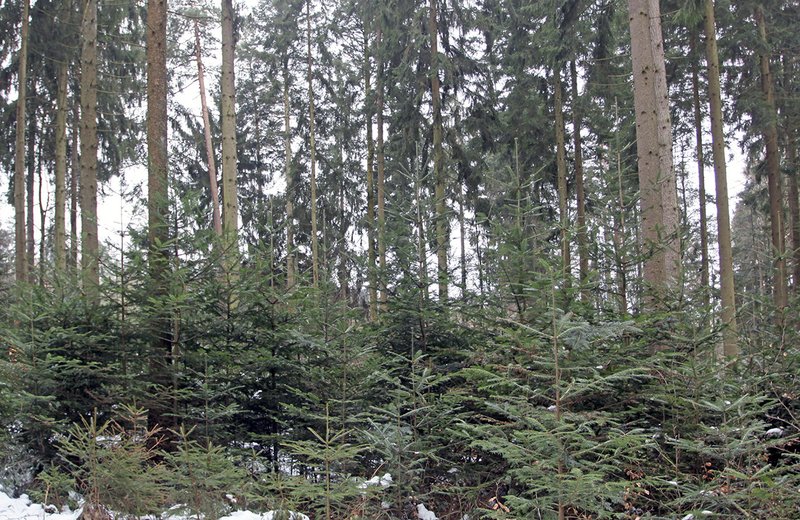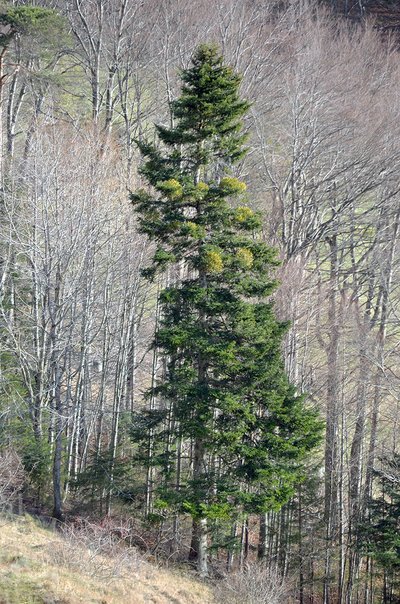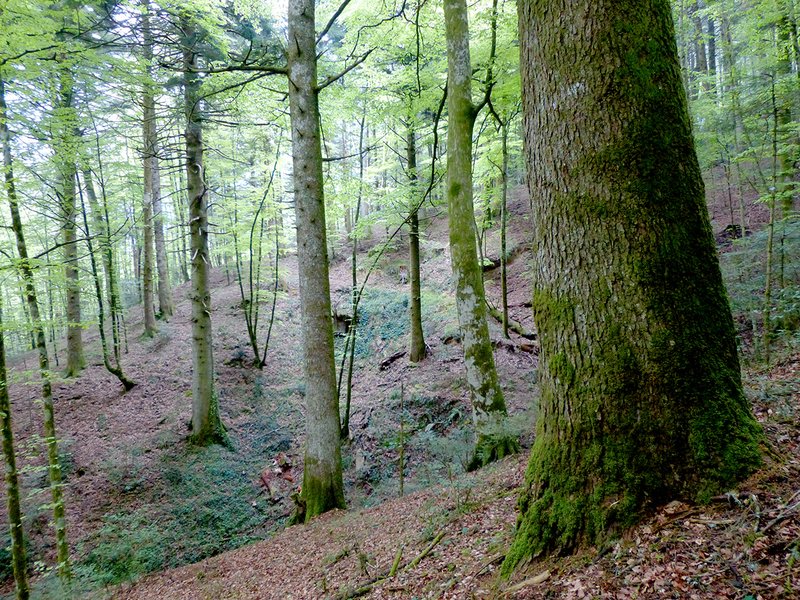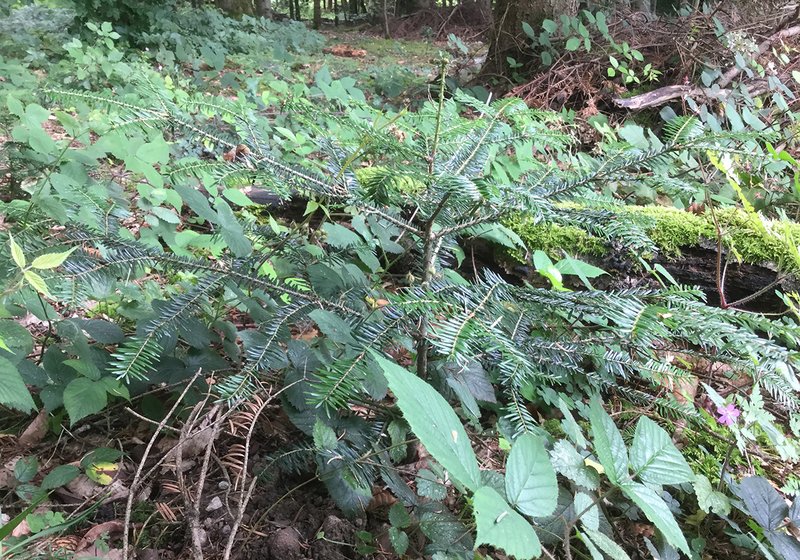Making up 15% of the growing stock in Swiss forests, the silver fir (Abies alba) is the third most common tree species in Switzerland. As well as its function in the protection forest, the silver fir is a commercially important species. The properties and uses of its timber are very similar to those of spruce. As its timber is easily impregnated, fir is a preferred choice for uses requiring resistance to moisture.
Wide ecological range
In Switzerland the silver fir is known as a characteristic species of sites with a good water supply in the montane areas of the Pre-Alps and the Northern Alps. It is just as typical across extensive areas of southern Tessin, the Swiss Plateau and the Jura Mountains, and has even advanced into inner-Alpine dry valleys such as Valais and the Grisons Rhine valley. Its distribution range in Switzerland thus includes very varied site conditions.
This ecological range is complemented by populations in southern, south-eastern and eastern areas of Europe. The silver fir thus has the qualities necessary to survive even under future conditions in Switzerland, presumably warmer and drier than today, and to continue to play an important ecological and economic role.
In the rather cool and humid climate of the early Holocene, the silver fir spread first in Tessin, and later also north of the Alps, forming stands in many places. As people began to live a settled life and the population grew, forest areas were cleared to make space for grain cultivation and pastures. Slash burning in particular had a negative impact on the silver fir, promoting oak or beech, which are less sensitive to fire.
The silver fir tends to have deep roots and is therefore better protected against drought and storm events than other tree species - which is one reason why the silver fir should be able to withstand the climate change to be expected better than the spruce, for example, which has shallower roots. Paleo-ecological data (pollen and macro-fossil remains found in bogs and lake sediments) also indicate the former presence of silver fir populations on sites that were warmer and drier than nowadays, and where they still occur in part today. Nevertheless, the silver fir in Switzerland has shown significant damage after the long droughts of recent summers.
It remains to be seen whether the provenances found here today will continue to grow here in the future or whether they will be replaced by those from warmer and drier regions. Natural dispersal, but also targeted cultivation could bring provenances adapted to sub-Mediterranean conditions to our latitudes. This raises questions as to how silver fir can be preserved or even promoted here in Switzerland, what role genetics can play in this, and what effect ecological factors such as browsing pressure may have.
Re-immigration from three glacial refugia
Genetic analyses of silver fir populations and palaeo-ecological studies have made it possible to map the re-immigration of tree species after the last ice age about 18,000 years ago. During the Last Glacial Maximum, the greater part of the Alps lay under a thick layer of ice, and the silver fir was not able to survive on the few ice-free sites. During this time, it had to hold out in areas with a more favourable climate, which are thought to have been in southern regions such as the Balkans, the northern Apennines and the Maritime Alps.
With the melting of the ice layer at the end of the Last Glacial Period, many tree species gradually returned to the area that is now Switzerland. This history of return migration can also be inferred from genetic analyses of Swiss silver fir stands when these are compared with the genetic pattern across the entire distribution area.
In Switzerland today, three genetic relationship groups have been identified (fig. 3): Two widespread groups are concentrated in the west and east respectively, while a third group is found mainly in Tessin and eastern Valais.
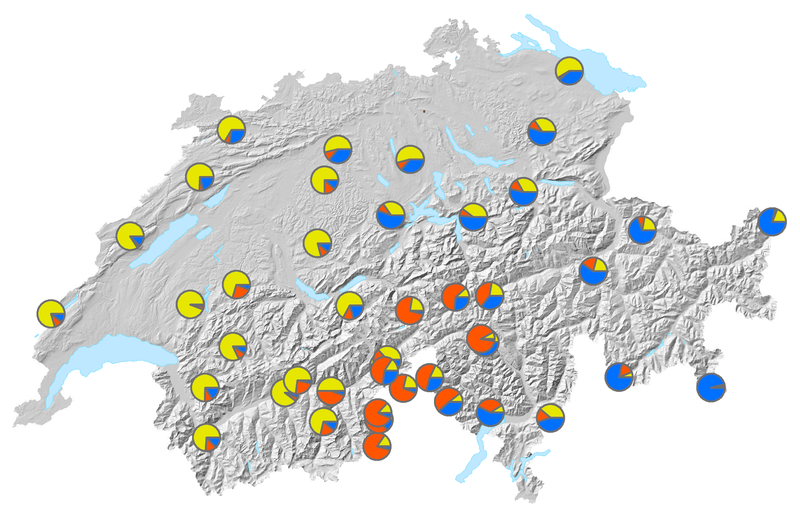
Fig. 3: Proportions of the three genetic relationship groups found in Swiss silver fir stands. The western group (yellow) probably came to Switzerland from France, the eastern (blue) from the Balkans, and the southern group (red) from the northern Apennines. Data from Folly and Gugerli 2013; Kramer 2020. Diagram: WSL/Swisstopo
This pattern probably emerged through the silver fir reaching eastern Switzerland from the northern Balkans or north-eastern Italy on one side, and western Switzerland from southern France on the other, from where it was then able to expand across the “Röstigraben” [cultural boundary between German- and French-speaking Switzerland] into central Switzerland. The third group migrated from the northern Apennines into the areas south of the main Alpine ridge.
The blurred transition between the two main genetic groups, i.e. the area where the return migration routes of the (south) eastern and western provenances have met, coincides with the biogeographical, known contact zone known as the “Gotthard line”, which is also found with other plant species. As a result of extensive genetic exchange through pollen and seeds, the genetic groups have however been thoroughly mixed - something which is apparent in the high proportion of the respective other genetic group usually found in the populations.
Distribution of the silver fir in Europe (Euforgen)
Distribution of the silver fir in Switzerland (infoflora)
Birmensdorf silver fir as a reference tree
To create an important basis for ecological-genetic studies, a consortium of 20 research institutions including the Swiss Federal Institute for Forest, Snow and Landscape Research (WSL) have decoded the complete genome of the silver fir. The tree they used to do this stands at the WSL in Birmensdorf. The complex analysis resulted in a still fragmentary image of the genome, but over 50,000 genes were found.
This information provides an important basis for further genetic research. Particularly interesting here is which gene variants prove to be advantageous under the site conditions to be expected in future, based on climate models. Such findings could help to promote genotypes in the forest that are adapted to future environmental conditions, or to identify suitable provenances to be planted as a supplement to natural regeneration.
Different growth strategies
Genetic analyses can help us learn more about the evolution and adaptation of the silver fir. Growth and phenology surveys from a large-scale provenance trial in Swiss stands showed for example that silver fir from provenances in warmer, climatically moderate locations (e.g. Central Plateau) grows taller. It was also possible to derive two growth strategies, dependent on the seasonal distribution of precipitation: “start early and grow slowly” in the inner-alpine valleys with summer drought, and “start late and grow fast” at the higher altitudes with a lot of rainfall.
As the environmental conditions at the trial site are the same for all provenances in provenance trials, differences in external characteristics must be due to genetics. Scientists analysed wood bore samples in two Swiss provenance trials in order to investigate growth and resistance to drought. In addition to long-term growth, growth before, during and after the extreme drought year of 2003 was measured in provenances from all over Europe.
The growth characteristics showed clear differences and signs of local adaptation. With regard to drought resistance, it was the local Central European provenances that tended to perform best, while the Eastern European ones outperformed the others in terms of long-term growth.
Interestingly, the study found large differences between the provenances. These came from refugia from different glacial periods, and can be identified on the basis of molecular-genetic markers. This suggests that the genetic adaptation to the site conditions in the glacial retreat area and during the return migration continues to have an influence on the growth of provenances today. However, for both studies it is true to say that it remains unclear which genes are responsible for these adaptations. Further molecular and experimental studies will shed light on this.
Genetically informed silviculture?
What practical insights can be derived from such genetic studies? Can they help to support future silvicultural strategies promoting silver fir in Switzerland? What gaps still exist in our knowledge?
It is important to distinguish between demographic processes on the one hand, especially as a result of post-glacial return migration, and adaptive processes on the other. In the former case, it is desirable to preserve the spatial distribution of the three genetic groups in Switzerland and thus their different histories as far as possible, for example in the case of seed transfers. Otherwise there is a risk of an outcrossing depression, for example - i.e. reduced fertility due to excessive genetic differences between the parent plants.
But the adaptability of silver fir populations also plays an important role with regard to the impending environmental changes. There are still however virtually no molecular genetic studies for silver fir that identify gene variants that are advantageous for adaptation to the future climate, and that could be promoted through silvicultural measures.
To ensure that the historical legacy of demographic processes and local adaptation through selection are integrated in silvicultural planning, we recommend that only seed of regional provenance is used. The provenances should be selected from sites with conditions that are similar or that tend to be warmer and drier than is currently the case at the planting site.
In recent years, the silver fir has proved to be a treasure trove for ecological and genetic research. Numerous projects currently underway show the undiminished interest in this tree species on the one hand, but also the sometimes quite contradictory expectations of its potential. It will thus be fascinating to observe how the future of the silver fir - or the silver fir of the future - will develop.
You will find literature references in the Original article, and references in the Bibliography.
Translation: Tessa Feller

